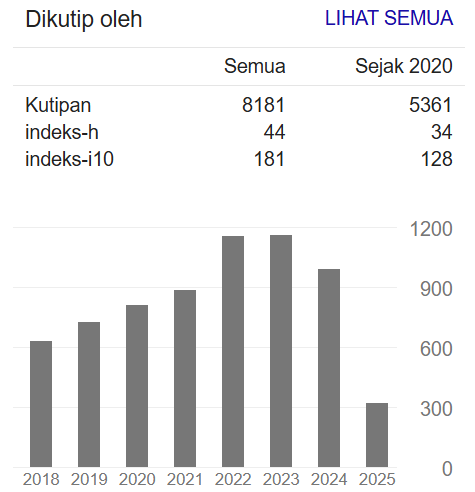RELATIONSHIP OF DIETARY INTAKE AND PHYSICAL ACTIVITY WITH BODY COMPOSITION IN ADULTS: A CASE-CONTROL STUDY
DOI:
https://doi.org/10.34011/jmp2k.v35i3.3230Keywords:
aktivitas fisik, asupan makanan, lemak viseral, massa otot, obesitasAbstract
Obesitas yang ditandai dengan kelebihan lemak tubuh dan gangguan komposisi tubuh menyebabkan gangguan kesehatan dan risiko tinggi terhadap kasus penyakit tidak menular. Penelitian ini bertujuan untuk mengevaluasi hubungan antara asupan karbohidrat, lemak, protein, serta aktivitas fisik dengan persentase lemak visceral dan massa otot pada individu dewasa yang mengalami obesitas. Studi analitik observasional ini menggunakan desain kasus kontrol, dengan merekrut 25 partisipan dengan status berat badan normal dan 25 partisipan obesitas. Pengumpulan data dilakukan menggunakan Semi Quantitative Food Frequency Questionnaire (SQFFQ) dan aktivitas fisik dinilai menggunakan International Physical Activity Questionnaire-Short Form (IPAQ-SF). Asupan makan dan aktivitas fisik tidak berhubungan dengan persentase lemak sementara, regresi linear ganda menunjukkan bahwa asupan karbohidrat (B = 0,007, β = 0,171, p = 0,028), aktivitas fisik (B = -0,001, β = -0,200, p = 0,028), jenis kelamin (B = 6,041, β = 0,522, p < 0,001), dan BMI (B = -1,021, β = -0,961, p < 0,001) merupakan prediktor signifikan untuk persentase massa otot. Temuan penelitian ini menunjukkan bahwa terdapat hubungan yang signifikan antara asupan karbohidrat dan aktivitas fisik dengan persentase massa otot setelah disesuaikan dengan faktor perancu. Konsumsi karbohidrat disertai aktivitas fisik dapat meningkatkan massa otot.
References
R. Ruze et al., “Obesity and type 2 diabetes mellitus: connections in epidemiology, pathogenesis, and treatments,” Front. Endocrinol. (Lausanne)., vol. 14, no. April, pp. 1–23, 2023, doi: 10.3389/fendo.2023.1161521.
X. Jin et al., “Pathophysiology of obesity and its associated diseases,” Acta Pharm. Sin. B, vol. 13, no. 6, pp. 2403–2424, 2023, doi: 10.1016/j.apsb.2023.01.012.
World Health Organization, “Obesity and Overweight,” World Health Organization.
R. I. Kemenkes, Survei Kesehatan Indonesia, vol. 01. Jakarta: Badan Kebijakan Pembangunan Kesehatan Kementerian Kesehatan RI, 2023.
C. J. Holmes and S. B. Racette, “The utility of body composition assessment in nutrition and clinical practice: an overview of current methodology,” Nutrients, vol. 13, no. 8, pp. 1–16, 2021, doi: 10.3390/nu13082493.
E. A. Murbawani, H. W. Subagio, N. Puruhita, E. Probosari, and A. Candra, “Correlation of dietary intake and physical activity with nutritional status, body composition and hand grip strength in elderly,” J. Gizi Indones. (The Indones. J. Nutr., vol. 10, no. 1, pp. 21–27, 2021, doi: 10.14710/jgi.10.1.21-27.
X. Liang, X. Chen, J. Li, M. Yan, and Y. Yang, “Study on Body Composition and Its Correlation With Obesity A Cohort Study in 5121 Chinese Han Participants,” Med. (United States), vol. 97, no. 21, 2018, doi: 10.1097/MD.0000000000010722.
L. Wang, H. Wang, B. Zhang, B. M. Popkin, and S. Du, “Elevated Fat Intake Increases Body Weight and The Risk f Overweight and Obesity Among Chinese Adults: 1991–2015 Trends,” Nutrients, vol. 12, no. 11, pp. 1–13, 2020, doi: 10.3390/nu12113272.
A. Bosy-Westphal and M. J. Müller, “Diagnosis of Obesity Based on Body Composition-Associated Health Risks—Time For A Change In Paradigm,” Obes. Rev., vol. 22, no. S2, pp. 1–7, 2021, doi: 10.1111/obr.13190.
L. A. da Costa Teixeira et al., “Analysis of Body Composition, Functionality and Muscle-Specific Strength of Older Women With Obesity, Sarcopenia and Sarcopenic Obesity: A Cross-Sectional Study,” Sci. Rep., vol. 14, no. 1, pp. 1–9, 2024, doi: 10.1038/s41598-024-76417-7.
M. Xing, Y. Ni, Y. Zhang, X. Zhao, and X. Yu, “The relationship between skeletal muscle mass to visceral fat area ratio and metabolic dysfunction-associated fatty liver disease subtypes in middle-aged and elderly population: a single-center retrospective study,” Front. Nutr., vol. 10, no. November, 2023, doi: 10.3389/fnut.2023.1246157.
R. Zamanillo-Campos et al., “Longitudinal Association of Dietary Carbohydrate Quality With Visceral Fat Deposition and Other Adiposity Indicators,” Clin. Nutr., vol. 41, no. 10, pp. 2264–2274, 2022, doi: 10.1016/j.clnu.2022.08.008.
D. Pescari, M. S. Mihuta, A. Bena, and D. Stoian, “Quantitative Analysis of the Caloric Restriction Versus Isocaloric Diets Models Based on Macronutrients Composition: Impacts on Body Weight Regulation, Anthropometric, and Bioimpedance Parameters in Women with Obesity,” Front. Nutr., vol. 11, no. December, pp. 1–21, 2024, doi: 10.3389/fnut.2024.1493954.
N. Leite et al., “Examining the Mediating Role of Muscle Quantity in Adolescents: Associations With Adiposity, Cardiorespiratory Fitness, Muscular Fitness, and Cardiometabolic Risk Factors,” Sci. Rep., vol. 14, no. 1, pp. 1–10, 2024, doi: 10.1038/s41598-024-61805-w.
N. Davoudzadeh, S. J. Masoumi, M. Nouri, and Z. Sohrabi, “Association of Pro-Healthy Diet Index and Non-Healthy Diet Index with Body Composition: Baseline Results from Cohort Study,” Int. J. Nutr. Sci., vol. 10, no. 2, pp. 136–145, 2025, doi: 10.30476/ijns.2025.101220.1293.
H. Nakaguchi et al., “Body Composition Changes and Factors Influencing the Total Weight Loss Rate After Laparoscopic Sleeve Gastrectomy,” Clin. Pract., vol. 14, no. 6, pp. 2608–2622, 2024, doi: 10.3390/clinpract14060206.
M. Look et al., “Body composition changes during weight reduction with tirzepatide in the SURMOUNT-1 study of adults with obesity or overweight,” Diabetes, Obes. Metab., no. February, pp. 2720–2729, 2025, doi: 10.1111/dom.16275.
A. Picca, F. Landi, and M. Cesari, “Editorial: Age-Related Changes in Body Composition: Mechanisms, Clinical Implications and Possible Treatments,” Front. Med., vol. 7, no. July, pp. 1–2, 2020, doi: 10.3389/fmed.2020.00230.
C. Bridger Staatz et al., “Life Course Socioeconomic Position and Body Composition in Adulthood: A Systematic Review and Narrative Synthesis,” Int. J. Obes., vol. 45, no. 11, pp. 2300–2315, 2021, doi: 10.1038/s41366-021-00898-z.
R. A. Rahmah, C. Panjaitan, and ovita H. Lucia, “Penyebab Terjadinya Obesitas pada Remaja Putri (10-24 Tahun),” Media Publ. Promosi Kesehat. Indones., vol. 6, no. 6, pp. 1097–1102, 2023, doi: https://doi.org/10.56338/mppki.v6i6.3263.
G. L. Austin, L. G. Ogden, and J. O. Hill, “Trends in Carbohydrate, Fat, and Protein Intakes and Association With Energy Intake in Normal-Weight, Overweight, and Obese Individuals: 1971-2006,” Am. J. Clin. Nutr., vol. 93, no. 4, pp. 836–843, 2011, doi: 10.3945/ajcn.110.000141.
J. Moon and G. Koh, “Clinical Evidence and Mechanisms of High-Protein Diet-Induced Weight Loss,” J. Obes. Metab. Syndr., vol. 29, no. 3, pp. 166–173, 2020, doi: https://doi.org/10.7570/jomes20028.
N. Fauziah, Analisis Data Menggunakan Multiple linear Regression Test di Bidang Kesehatan Masyarakat dan Klinis, Gurid Pram. Bandung: Politeknik Kesehatan Kemenkes Bandung, 2020.
J. Antonio, D. G. Candow, S. C. Forbes, M. J. Ormsbee, P. G. Saracino, and J. Roberts, “Effects of dietary protein on body composition in exercising individuals,” Nutrients, vol. 12, no. 6, pp. 1–11, 2020, doi: 10.3390/nu12061890.
K. R. Devi, R. Potsangbam, P. D. Okram, A. Devi, and C. S. Devi, “Association Between Body Fats Distribution and Body Mass Index With Lipid Profile in Young Adults,” Int. J. Dent. Med. Sci. Res., vol. 3, no. 6, pp. 503–508, 2021, doi: 10.35629/5252-0306503508.
S. M. Jeong, D. H. Lee, L. F. M. Rezende, and E. L. Giovannucci, “Different Correlation of Body Mass Index With Body Fatness and Obesity-Related Biomarker According to Age, Sex and Race-Ethnicity,” Sci. Rep., vol. 13, no. 1, pp. 1–11, 2023, doi: 10.1038/s41598-023-30527-w.
S. C. P. Lewa and P. Amani, “Hubungan antara Perilaku Makan dan Aktivitas Fisik dengan Komposisi Tubuh pada Siswa Sekolah Menengah,” JPP (Jurnal Kesehat. Poltekkes Palembang), vol. 19, no. 2, pp. 124–131, 2024, doi: 10.36086/jpp.v19i2.2570.
F. D. Sasri, F. Witjaksono, and N. C. Sudarsono, “Correlation of Energy Intake and Physical Activity,” World Nutr. J., vol. 7, no. 1, pp. 30–35, 2022, doi: 10.25220/WNJ.V07.i1.0006.
J. B. Gauvain et al., “Correlation between Muscle Mass and Physical Activity Level in Older Adults at Risk of Falling: The Fitness Study,” J. Frailty Aging, vol. 13, no. 3, pp. 240–247, 2024, doi: 10.14283/jfa.2024.53.
S. Nishikori and S. Fujita, “Association of Fat-To-Muscle Mass Ratio with Physical Activity and Dietary Protein, Carbohydrate, Sodium, and Fiber Intake in A Cross-Sectional Study,” Sci. Rep., vol. 14, no. 1, pp. 1–9, 2024, doi: 10.1038/s41598-024-61289-8.
P. H. Lee, D. J. Macfarlane, T. H. Lam, and S. M. Stewart, “Validity of the International Physical Activity Questionnaire Short form (IPAQ-SF): A Systematic Review,” Int. J. Behav. Nutr. Phys. Act., vol. 8, no. 1, p. 115, 2011, doi: 10.1186/1479-5868-8-115.
K. Meh, G. Jurak, M. Sorić, P. Rocha, and V. Sember, “Validity and Reliability of IPAQ-SF and GPAQ for Assessing Sedentary Behaviour in Adults in the European Union: A Systematic Review and Meta-Analysis,” Int. J. Environ. Res. Public Health, vol. 18, no. 9, 2021, doi: https://doi.org/10.3390/ijerph18094602.
R. Smith, G. McHugh, J. Quicke, K. Dziedzic, and E. Healey, “Comparison of Reliability, Construct Validity and Responsiveness of the IPAQ-SF and PASE in Adults with Osteoarthritis. Musculoskeletal Care,” Musculoskeletal Care, vol. 19, no. 4, pp. 473–483, 2021, doi: https://doi.org/10.1002/msc.1540.
Downloads
Published
How to Cite
Issue
Section
Citation Check
License
Copyright (c) 2025 Inggrit Bela Thesman, Dono Indarto, Yuliana Heri Suselo

This work is licensed under a Creative Commons Attribution-ShareAlike 4.0 International License.




